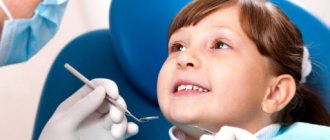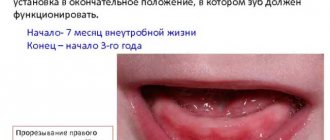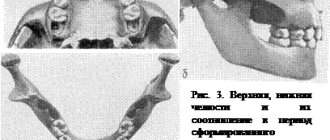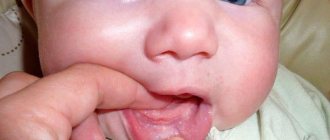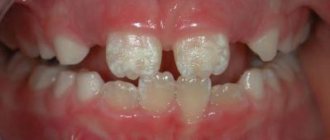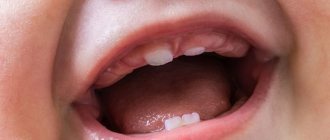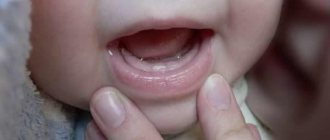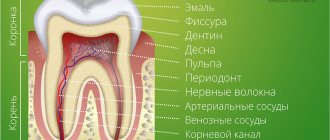- Crooked teeth
- The appearance of a second row of teeth in the jaw
- When permanent teeth do not appear for a long time
- How to distinguish baby teeth from permanent ones?
The complex process of replacing baby teeth with permanent ones is often painful and accompanied by a number of problems. The most common of them is malocclusion. The second most common problem is the appearance of a second set of teeth. Also, many parents are faced with the fact that their child’s molars and incisors do not appear for a very long time.
Crooked teeth
If permanent teeth begin to grow unevenly, you need to come for a consultation with an orthodontist at the A-Medic Network of Medical Clinics as soon as possible. The sooner such a decision is made, the easier it will be for the dentist to correct their growth. An incorrect bite is not only inconvenient, it can lead to the development of a number of diseases, for example, caries, stomach diseases, and cause childhood and teenage complexes and psychological problems.
The easiest way to straighten your jaw is to wear braces. It is very important for parents, together with the attending physician, to explain to the child that temporary inconveniences when using braces are justified and will bring invaluable benefits in the future. You need to take good care of it, because it will stay in your mouth for at least six months. This design will work most effectively during adolescence. Small children can more easily tolerate plates or trainers, which look something like boxing mouthguards, rather than braces. Children's enamel is quite delicate, so trainers that do not damage it will be the best way to correct a child's malocclusion.
In what cases can a child grow a second row of baby teeth?
The rudiments of baby teeth are formed very early, even before the baby is born, so disturbances in their growth are a consequence of the lack of space in the jaw to accommodate all the teeth.
What can lead to improper formation of buds or insufficient jaw size?
- Poor nutrition of a woman during pregnancy. For the proper formation of the baby’s body, including his future teeth, it is necessary that the mother receives vitamins and minerals in the quantities that she and the child need. If there are not enough of them, then the deficiency can lead to disruption or slowdown in the growth of both the rudiments of future teeth and the jaw bone.
- Lack of calcium and fluoride as the main elements for maintaining dental health in a child’s diet. It is necessary to carefully monitor how the baby eats so that the peculiarities of food do not become a problem for him and his teeth in the future.
- Avoiding solid foods in the infant's diet. Gnawing on harder foods is a necessary action that helps to properly position the erupting baby teeth in the jaw. If the baby receives only soft or liquid food, then he does not have the opportunity to correctly identify the places for all the baby teeth.
- Genetic predisposition to problematic growth of baby teeth. Unfortunately, genetics also influences crooked teeth. But don’t worry, because modern pediatric dentistry offers many ways to correct a child’s bite without much worry for both him and his parents.
Teeth are growing incorrectly - can this be corrected?
Of course, there are ways to correct disturbances in the growth of both primary and permanent teeth, including the growth of their second row in a child - it is difficult; a dental plate most likely will not help. You can often hear a myth that the incorrect growth of temporary teeth does not need to be corrected, because with age they are still replaced by permanent ones. This is a fundamentally wrong approach. In addition to the child developing complexes and frequent pain from malocclusion, curvature of baby teeth can lead to growth disturbances in permanent teeth, which is much more difficult to correct.
However, if permanent teeth require correction, then this is also not a reason to be too upset: orthodontists can recommend a lot of ways to correct abnormal growth of permanent teeth (aligners, trainers, braces).
Braces are placed at older ages - teenagers or adults. Since at this time the roots of permanent teeth are already formed, correction takes much longer than if it began in childhood. Often, wearing braces lasts for a year and a half, and sometimes for longer.
Whereas a doctor may prescribe a mouthguard or trainer for a child. In general, when correcting a bite, the rule is true: the sooner the better, which should always be kept in mind when detecting any problems with the arrangement of teeth in the jaw.
Of course, during the correction it is also necessary to maintain careful oral hygiene. Correction systems in the mouth can trap pieces of food, which subsequently become a good environment for microorganisms. This can lead to problems with the enamel, and in the longer term, even to caries and tooth decay.
Therefore, Asepta recommends using products to ensure oral hygiene. We have developed toothpastes specifically for children - they carefully clean, protect enamel from caries, and saturate it with minerals. Pastes also help get rid of food debris and prevent the proliferation of microorganisms on the teeth while wearing correction systems, and the antiseptic component in their composition helps disinfect the oral cavity.
What to do if a child’s tooth grows in the second row?
Sometimes such teeth sit so tightly in the gums that only their surgical removal can solve the problem. If precious time was missed, during which it was possible to easily return the permanent teeth to their place or allow them to erupt correctly, then retention may occur. Retention is the incomplete eruption of a tooth, in which it remains a small part inside the gum or, conversely, is almost completely hidden in it. It is much more difficult to correct than correcting abnormally growing permanent teeth. Therefore, it is worth paying attention to problems with a child’s bite as early as possible, even before his temporary teeth begin to change to permanent ones.
Only a dentist can make any decision regarding an impacted tooth and only after a complete examination of the small patient’s jaw. To do this, a complete photograph of the jaw is taken, which clearly shows the location of the tooth and possible paths of development of events. Next, the doctor may resort to either making an incision in the gum, followed by installing a brace system on the teeth, or removing the tooth, if nothing can be done to help. The latter, however, rarely happens. More often than not, doctors try to find a way out of any situation, and braces systems currently make it possible to solve almost any problem with an impacted tooth.
Therefore, if you notice that your child is growing second row of milk or permanent teeth, you should not panic, but you should not lose sight of the situation either. Make an appointment with a doctor and get examined. The dentist will assess the situation and offer the best approach to solving the problem. Early contact with a doctor is the key to quick treatment.
Take care of the health of your loved ones with Asepta!
The appearance of a second row of teeth in the jaw
Each canine, incisor and molar has its own place, but sometimes a child's permanent teeth begin to form a second row. This often happens when the milky ones have not yet fallen out, but the radical ones have already begun to appear. An undeveloped jaw that provides too little room for growth can also be a source of the problem. The third reason is that the incisors and canines in the second row are “superfluous”, or supernumerary.
The second row of teeth is not only inconvenient, but also unsightly, so the problem needs to be solved. A baby tooth that does not fall out in time can be removed in the clinic. If the reason for the formation of the second row is underdevelopment of the jaw, then the dentist can remove several teeth and install braces on the remaining ones.
Reasons for the growth of the second row of teeth in a child
Improper eruption may be due to several factors:
- First of all, there is a hereditary predisposition to this. There is a high probability that if a parent’s milk teeth do not have time to leave the gums before the permanent ones appear, then this will also manifest itself in the child.
- Infectious and chronic diseases can affect both the growth of permanent teeth and the rate of loss of primary teeth.
- Poor nutrition and lack of vitamins can often lead to abnormalities in the development of teeth, including the fact that a child’s baby or permanent teeth begin to grow in a second row.
- Problems with the development of baby teeth that can lead to problems with permanent teeth.
- Disturbances and incorrect initial location of tooth buds. In this case, they can not only grow in a second row, but also be curved in different directions, as well as rest against each other, which can lead to both retention and malocclusion and sometimes even chipping of pieces of teeth.
If you notice that your child is growing second row of baby or permanent teeth, then immediately contact your pediatric dentist. As a rule, a specialist recommends removing a baby tooth that is interfering with proper growth or waiting for it to fall out on its own. If you decide to wait, you need to increase the thoroughness of caring for your child's oral cavity.
When permanent teeth do not appear for a long time
The absence of permanent teeth for too long can be due to several reasons: these are the genetic characteristics of the body, their immaturity, and the destruction of tooth germs by some kind of infection.
Only a dentist can determine the true cause. At the A-Medic Network of Medical Clinics clinic, they will take a picture of the jaw, which will show how the child’s permanent teeth are formed. Sometimes they can grow inside the gums. If nothing is visible on the image, the doctor may suggest solving the problem by installing dentures.
Timing of baby teeth eruption
Now you know the correct sequence for the eruption of baby teeth, all that remains is to figure out what time to wait for the teeth to appear. At this important stage of the baby’s growing up, all parents are interested in the timing of tooth growth in children.
As a rule, a newborn baby does not have milk teeth, but there are rare cases when teething begins even before birth. The fact that children are born with a baby tooth is not considered a deviation from the norm. However, the optimal age for the eruption of the first primary teeth is approximately 6 months.
The usual time for baby teeth to erupt in children is from five months to three years. The lower incisors appear first at the age of 5–7 months, then the upper ones. The period of eruption of milk teeth, called molars, can last from a year to a year and a half, and this is not a violation of the deadlines. Then comes the turn of the canines and second molars. The appearance of the last milk teeth and the final formation of the bite in children ends at approximately 2.5 years. Below is a table with deadlines.
Table of timing of baby teeth eruption
| Name of teeth | Timing of eruption in months | |
| Upper jaw | Lower jaw | |
Anterior incisor | 6 | 7,5 |
Lateral incisor | 7 | 9 |
First molar | 12 | 14 |
Fang | 16 | 18 |
Second molar | 20 | 24 |
How to distinguish baby teeth from permanent ones?
Both molars and baby teeth have a similar structure, but have a number of external differences.
- Thus, milk ones are on average lighter and whiter than permanent ones, which are distinguished by a yellowish enamel tone.
- On average, a molar is larger than its primary tooth.
- Permanent ones have a thicker layer of hard tissue and a less developed pulp.
- Dairy varieties have thinner and shorter roots.
It is important for all parents to remember that both baby and permanent teeth of children must be protected, and any problems that arise in their growth and development must be resolved immediately. Specialists from the “A-Medic” network of medical clinics can help them with this.
Baby teeth in children: order of eruption
Any newborn baby has follicles of milk teeth (20 pieces) and molars (16 pieces) inside the jaws. The remaining 16 rudiments will form later.
Teething in infants begins with the lower jaw: first the central incisors appear (6-10 months of the child’s life), then the canines (10-13 months), then comes the turn of the first (14-18 months) and second (17-23 months) molars .
Emerging teeth differ from adult teeth in having low-mineralized enamel. If you do not maintain oral hygiene, caries may begin to develop. In addition to careful adherence to hygiene rules, special gels and ointments that significantly accelerate the mineralization process will help make teeth stronger and more resistant to pathogenic microorganisms.
Complications during the eruption of baby teeth
The process of teething is a huge burden on a child’s body, so it is associated with some unpleasant sensations. Decreased appetite, insomnia, crying and fever are normal. Most likely, the child will be capricious, scream, and try to chew various objects to relieve the itching of the gums, and parents should be mentally prepared for this. However, a temperature above 38 degrees that persists for a long time is an alarming symptom of teething in children; in such circumstances, it is better to consult a specialist.
Sometimes a purple spot may appear on the baby's gum - a teething hematoma. It indicates that the tooth has already begun to erupt through the mucous membrane, but cannot pass further for a number of reasons: infection, improper development of teeth or lack of free space. This is associated with difficulty in teething. Later, a small formation may be seen at the site where the tooth should appear - a dentition cyst. Under no circumstances should you self-medicate; this will lead to improper eruption of baby teeth, infectious diseases and tissue damage. It is necessary to consult a doctor who will quickly and painlessly help the tooth erupt.
